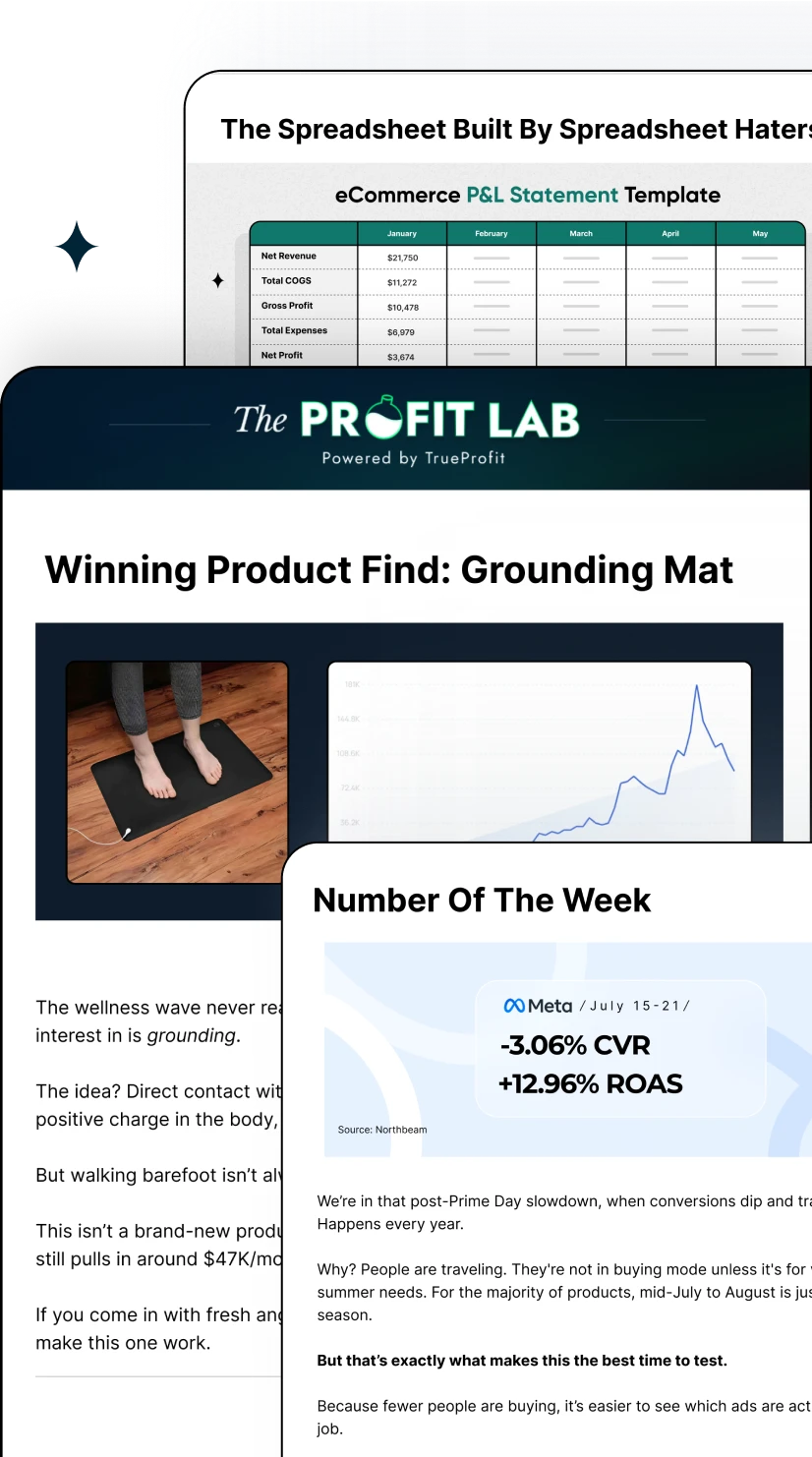What is Dropshipping Shipping Fee & How to Deal with It?

Shipping fees are one of the most common and significant costs in a dropshipping business. Even though retailers don’t have full control over shipping fees, it still directly impacts the store's success in three major ways: profit margin, pricing strategy, and customer experience.
In this guide, we’ll walk you through dropshipping shipping fees step by step:
- What is it?
- What's the standard shipping fee?
- Key factors suppliers use to charge fee
- And proven strategies to manage it
Let’s dive in.
What is Dropshipping Shipping Fee?
In dropshipping, suppliers handle the packaging, logistics, and shipping the products to retailers’ customers. These services come at a cost—known as the shipping fee.
TrueProfit analyzed 1,000+ Shopify stores in August 2025 and found the average cost breakdown: ad spend takes up around 45%, COGS 35%, shipping 6.5%, transaction fees roughly 5%, and other costs close to 8.5%. With shipping fees ranking third, even small improvements can have a noticeable impact on profits.
Shipping fees can vary widely depending on weight, size, location, and delivery speed. For example, if a store owner sells a product from AliExpress, according to its current shipping rules, AliExpress will charge $1–$5 for standard shipping, while faster express options can range from $10–$20, depending on the item and country.
Remember, there’s no such thing as “free shipping” without retailers sacrificing anything in return. “Free shipping” claimed by dropshipping suppliers only means the cost is already added into the wholesale price, or they’ll provide some shipping options that take weeks or half-months to arrive.
How Much is a Standard Shipping Fee in Dropshipping?
Standard shipping from China fulfillment locations typically ranges from $1 to $5 per item. This is often called “economy” or “registered air mail” and can take 10–30 days depending on the destination.
Standard shipping from US/EU-based suppliers is usually faster, but slightly more expensive, around $3 to $10 per item.
Meanwhile, express shipping options like DHL or FedEx can cost $15–$30 per item. While express shipping is faster, it’s not available everywhere. Many suppliers only offer it to select countries, which can limit delivery options for some customers.
A good benchmark is choosing standard shipping that’s generally slower than express options but usually the cheapest way to protect your profit margin.
5 Key Factors Suppliers Use to Calculate Shipping Fees
Shipping fees aren’t set randomly—they are carefully calculated based on key measurable factors.
Here are 5 key factors dropshippers should consider when calculating shipping costs:
1. Fufillment Location
The supplier’s location plays a crucial role in dropshipping. Shipping from China to the U.S. used to be very affordable, with standard shipping under $5 and 10–20 day delivery times.
Today, trade policy changes constantly have made this route less predictable. Many dropshippers are now choosing U.S-based fulfillment for European customers. It costs more but provides faster, more consistent delivery.
2. Shipping Destination
Where a package is going also greatly impacts shipping rate. Distance, trade agreements, customs rules, and political factors all play a part.
For example, shipping a 1kg package from China to the U.S. West Coast via sea freight costs about $1,802 per container, while sending the same package from the U.S. to Europe ranges from $63.25 to $204.89 depending on service level.
On top of that, every country has its own import duties and taxes, which can further affect costs.
3. Weight of the Products
Heavier items cost more to ship, for example, a supplier might set a base shipping fee for items up to 0.3 kg, then add extra for each additional kilogram.
In that case, $4 covers the first 0.3 kg, and each extra kilogram costs $9. So, a 1.5 kg item would incur a shipping fee of $4 + (1.2 kg × $9) = $13.80.
4. Value of the Order
In fact, this is more like a hidden tactic among dropshipping suppliers. For instance, some suppliers might provide free shipping for orders over $30, while others may offer discounted rates for larger orders. This strategy encourages customers to purchase more items to qualify for better shipping deals.
But for dropshippers, this can mean slightly higher shipping fees on low-ticket products.
5. Dimensional Weight
For large but surprisingly light items, carriers often use dimensional weight to calculate shipping costs. It’s basically a way to charge based on how much space a package takes up, not just how heavy it is.
It’s calculated like this:
For example, imagine your box measures 50 cm long, 30 cm wide, and 20 cm tall. Using air freight with a dimensional factor of 5000, the dimensional weight comes out to 6 kg. Even though the box actually weighs just 3 kg, the shipping cost is calculated as if it weighs 6 kg.
How to Manage Shipping Fees for Healthy Profit Margins
Shipping fee is not the cost retailers can control directly, but they still impact the bottom line. The good news is, there’re clever ways to manage them without eating into your net profit.
Here are 5 recommendations from Harry Chu, founder of TrueProfit:
1. Offer “Free Shipping” and Adjust Product Prices
It simply means folding shipping cost into the product price and letting customers pay it for themselves.
Imagine the supplier charges $15 for the product and $5 for shipping. But you need at least $7 profit per order to keep net profit margin healthy. So, the solution was to markup this $15 candle set to $30 with free shipping. Customers feel they’re getting free delivery, and your profit margin remains intact.
Remember, $30 is the ideal scenario. The realistic markup price can flexibly change to make sure $7 net profit remains after covering all shipping fee, COGS, and other acquisition customer costs. And this tactic works best for low-ticket items where the product cost itself is cheap. High-ticket items plus markup shipping fees will scare off customers and kill product demand.
2. Offer “Free Shipping” and Lower Profit Point
In this tactic, sellers pay the shipping fees rather than passing it on to customers.
For example, a retailer buys a product for $10, pays $3 for shipping, and sells it for $20 with free shipping. After costs, the net profit drops to $7 → $4 because the retailer covers shipping out of their own margin.
The trade-off is simple: lower profit per order but potentially higher sales volume, which usually end up equally good bottom line in the long-term.
Yet, just be careful — this only makes sense with lightweight, low-cost-to-ship products. Applying it on bulky items with high shipping cost will end up shrinked profit margin.
3. Charge a Low Flat Shipping Rate
Another effective tactic is to charge customers a small, flat shipping fee for all orders. It’s ideal for stores with a consistent product catalog (like accessories, apparel, or beauty products).
Here’s how it works: Suppose your supplier charges $5 for shipping on each order. Instead of eating that full $5 or passing it on directly, you decide to charge customers a flat $2.99 shipping fee across your store.
In this case, you’ve protected your margin by sharing the cost with customers instead of paying it all.
You can mix and match these strategies depending on product type, price point, and shipping destination. For example, offer free shipping on small, high-margin products, but charge a flat rate for heavier or bulkier products.
4. Stay Ahead of Profit Margin
Optimizing shipping fees is important, but it’s meaningless if it doesn’t actually improve your bottom line. Regularly reviewing your profit margin to ensure every small change contributes positively to your business. Use this free dropship profit calculator—allow you to test different shipping rates and see the real impacts on your profits.
Smartly Monitor Shipping Fees and Other Costs
Understanding shipping fees isn’t enough—retailers need to understand how they impact the bottom line and explore effective ways to optimize it since there are certain products that can be sold at higher price if you can deliver them faster than your competitors.
This obviously means you would have to partner with delivery partners that utilises high tech tools like free route planner and fleet management softwares that will be able to deliver your products at a faster rate but will charge more to that do.
The key is to treat shipping like an important cost and monitor it regularly. Use TrueProfit, a net profit analytics tool that lets Shopify dropshippers track and monitor all expenses such as COGS, ad spend, shipping fee, and more.
With TrueProfit’s comprehensive expense tracking system, you can:
- Fully track all business expenses like COGS, ad spend, shipping cost, transaction fees or any other types of fees you have to pay.
- Identify which costs are eating into your profit margins and actively optimize them.
- Instantly see the impacts of any tactics you do on your bottom line - net profit.
By monitoring cost using TrueProfit, you can adjust your shipping fees and strategies confidently without guessing.
Leah Tran is a Content Specialist at TrueProfit, where she crafts SEO-driven and data-backed content to help eCommerce merchants understand their true profitability. With a strong background in content writing, research, and editorial content, she focuses on making complex financial and business concepts clear, engaging, and actionable for Shopify merchants.







